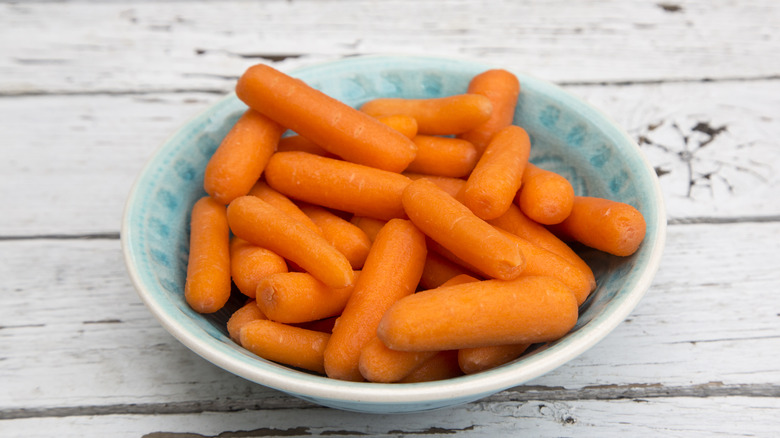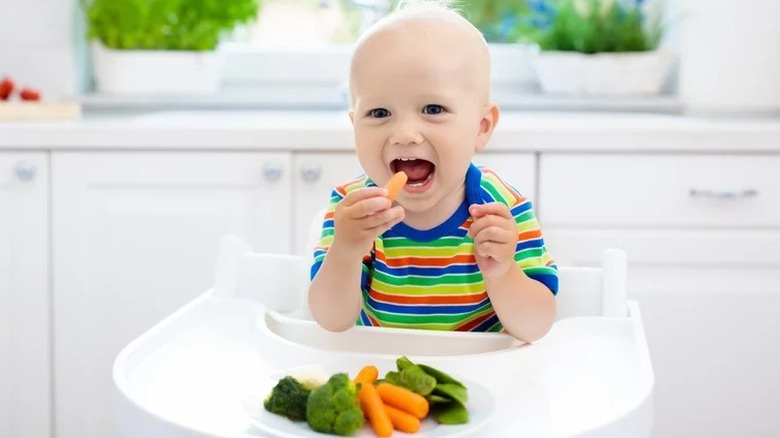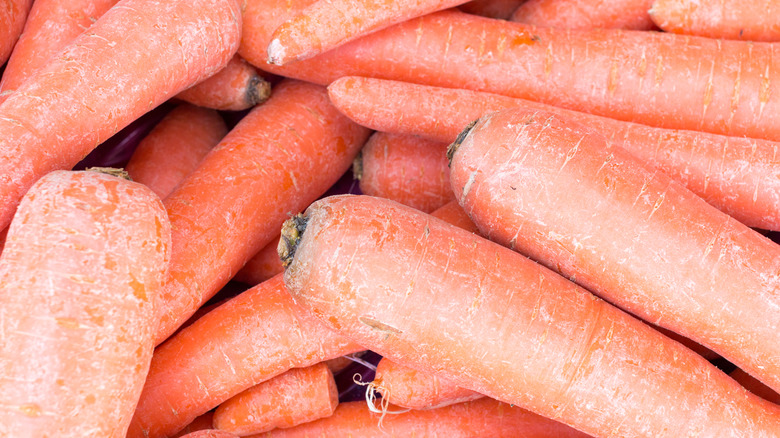What's The White Stuff On Your Baby Carrots Anyway?
If you've ever arranged a crudités board, snacked on hummus, or had a child under the age of 12 living in your household, you've more than likely handled your fair share of baby carrots – those eminently dippable veggies. The ultimate in snacking convenience, especially when you're looking for a healthier nosh, baby carrots are typically sold in plastic bags in your supermarket's refrigerated produce case.
When you've purchased baby carrots, you've likely noticed that they often don't look purely orange, but instead carry a white film on their surface. After being cut, baby carrots are washed in a diluted chlorine bleach solution, which the U.S. Food and Drug Administration (FDA) recommends as a food safety measure (via Water Quality and Health Council). As a result, rumors have sprung up that this white film is visible chlorine, and a reason to avoid baby carrots.
But according to Mental Floss, that white stuff is something else entirely — and it's perfectly safe to eat.
'Carrot blush' is totally harmless
According to Mental Floss, the white film you sometimes see on baby carrots isn't chlorine, mold, or any other substance that would be unsafe to eat, but is rather a completely natural phenomenon known within the fruit and vegetable industry as "carrot blush." Sometimes seen on full-sized, skin-on carrots as well, carrot blush is a result of the packaged root vegetables losing moisture over time — from the day of harvest until the day you pack them into your crisper drawer.
As the surface of the carrot is exposed to air, thereby drying out, it becomes rough, causing any light that hits the carrot to become scattered and give off a white or off-white appearance (via McGill University). Also, as baby carrots jostle together during packing, shipping, and storing, cells on the surface of the vegetable can become damaged, which also creates that somewhat unnerving white appearance.
That white film has a lot to do with how baby carrots are made
You might already know this — or you might not — but "baby" carrots aren't a natural product at all. Sure, you can yank carrots out of the ground when they're underdeveloped and they'll be baby-sized, but that wouldn't be a very cost-effective strategy for big companies, which, rather, make baby carrots by trimming larger carrots with mechanized processing equipment. According to Craving Health, the chubby, diminutive carrots are a way to cut down (pun intended) on food waste by utilizing gnarled or weirdly shaped full-sized carrots that wouldn't sell well, or using up bumper crops of carrots before they go bad.
Because of all that extra surface area that gets exposed to air throughout the production and shipping process, carrot blush sets in on the baby varieties way more often than it does on full-sized carrots. But never fear: Restoring the cute veggie's appearance is a simple matter of soaking them in cold water for a few minutes to add back some of the moisture they've lost (via Mental Floss). If the carrots still appear white after their bath, the white film is likely due to cellular damage. Either way, both causes of carrot film are benign and the vegetables are totally safe to eat.


